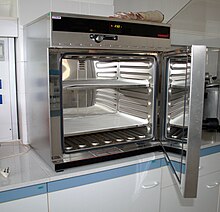Drying cabinet
A drying cabinet (also: drying cabinet or drying cabinet ) is a device for dehumidifying an object, usually by dehumidifying the air, using hygroscopic materials ( sorbents ). Drying cabinets are available for temperature ranges from room temperature to around 250 ° C. The size ranges from 30 liters to a few hundred liters or entire rooms, so-called dry rooms .
The execution as a climatic cabinet enables the storage of z. B. food or material samples under defined temperature and humidity conditions.
Areas of application
- Libraries and Archives : To protect media such as microfilms, recording media, CDs, DVDs or albums.
- Drying : Preservation of food by removing water.
- Electronics industry : Moisture-sensitive components (MSD) such as ceramic capacitors, QFPs, BGAs, LEDs, OSP-coated circuit boards. Ideal storage below 5% relative humidity.
- Forensics : Drying cabinets are used to restore DNA that has been destroyed by moisture.
- Industry : metal tools and fine ceramic fluxes.
- Laboratories : Store experiments, tablets, powdered medicine, slide samples, delicate instruments, inoculants, or germinating seeds in a humidity-controlled environment.
- Museums : store antiques, strung instruments, swords, old documents without damage from oxidation and mold.
- Optical industry : microlenses, liquid crystal glass, microscope lenses.
- Private use : For albums, cameras, beads, stamps, documents, bags, flowers, weapons or watches. In the Asian region, drying cabinets have been used for a long time, especially by consumers for storing food such as flour, sugar and salt.
- Solar industry : Solar cells (semiconductors) and the coated solar film are also particularly sensitive to moisture and must therefore be stored in a controlled manner in an environment with less than 5% relative humidity.
Drying methods
Baking process
Most drying cabinets are set up like a conventional electric oven . With simple models, only the temperature can be regulated. When electronic components are dried, the wettability of the connections decreases after baking and the components are exposed to considerable thermal stress.
Adsorption process
In adsorption drying , either a rotor or a chamber system is used for dehumidification. In contrast to the rotor, the chamber dehumidification works in time segments and therefore does not dehumidify permanently, but has a lower power consumption, is denser and thus achieves lower levels of humidity. First, the process air is passed through a container with a zeolite bed. There the water molecules are filtered out of the process air by adsorption and stored in zeolite A. With increasing saturation, the hygroscopic properties of zeolite A decrease. To regenerate zeolite A, it is removed from the process air and transported to the outside air. This is usually done via a valve or flap system. There, the moisture is driven out of the zeolite A with heated air of approx. 200 ° C and vented to the environment. After this process, known as regeneration, the filter unit is returned to the process air flow. This process achieves relative humidity below 0.5%.
Nitrogen process
The nitrogen is used to displace moist air in the cabinet by purging it. Large amounts of nitrogen are necessary for this, since a correspondingly pure nitrogen atmosphere can only be created by replacing the cabinet contents several times. Then stabilization is achieved via a small constant volume flow. The process is very energy-intensive and generates high running costs.
Other procedures
There are also models in which the pressure can also be regulated.
Drying process
If the moisture is withdrawn from the process air to below 5% relative humidity, the vapor pressure difference becomes so great that the water molecules in the objects to be dried overcome their adhesive forces and are released back into the process air. The items are dried. With an atmosphere of 1 or 2% relative humidity at room temperature (this corresponds to a water vapor content of less than 0.6 g / m³), a “moisture vacuum” is actually created. This means that moisture that has already been absorbed is released again. A re-drying process takes place. This is gentle, as the objects to be dried are not exposed to any thermal stress and there is therefore no risk of oxidation or internal metal growth (in the case of components). The drying time can be shortened by thermally supporting the process. In order to avoid oxidation problems, it is imperative that this process also takes place in a “moisture vacuum”. The classic annealing at very high temperatures is thus superfluous.
Background corrosion and oxidation
There is no corrosion in a dry atmosphere . Two prerequisites must be met for corrosion to occur: An oxidizing agent and an aqueous solution that acts as an electrolyte must be present. The oxygen in the air forms the oxidizing agent, the water vapor ( humidity ) the electrolyte. The critical limit at which oxidation with atmospheric oxygen takes place is 40 - 70% RH, depending on the metal or alloy. This means that there must be more than 8 grams of water vapor per m³. The absolute humidity in modern dry storage cabinets is less than 1.4 g / m³ at a temperature of 60 ° C and 1% RH, and 0.5 g / m³ at 40 ° C. Under these conditions, no cathode reaction and thus no more oxidation can take place. There is no need to eliminate the oxygen, as in a nitrogen storage cabinet.
literature
- "Textbook of Metal Corrosion" by Karl Müller, Galvanotechnik textbook series, Eugen G. Leuze Verlag, Saulgau (Württ.)

